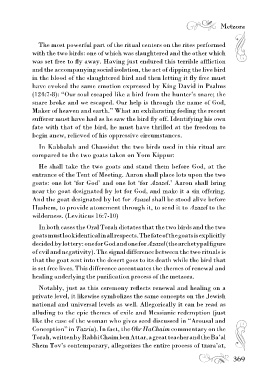Page 369 - 24107
P. 369
Orchard of Delights 12 Metzora # 24107-EYAL - 24107-EYAL | 12 - A | 18-01-28 | 12:12:05 | SR:-- | Black 24107-EYAL - 24107-EYAL |
#
Following these steps, on the eighth day, the metzora brought The most powerful part of the ritual centers on the rites performed
a number of sacrificial offerings accompanied by olive oil. The with the two birds: one of which was slaughtered and the other which
cohen took the sacrificial blood and olive oil and placed some on was set free to fly away. Having just endured this terrible affliction
the metzora’s right ear, thumb, and toe. The remainder was placed and the accompanying social isolation, the act of dipping the live bird
on the metzora’s head. The sin and elevation offerings were then in the blood of the slaughtered bird and then letting it fly free must
brought and with this the purification and atonement process was have evoked the same emotion expressed by King David in Psalms
completed. (124:7-8): “Our soul escaped like a bird from the hunter’s snare; the
snare broke and we escaped. Our help is through the name of God,
Rashi explains that each component of the ritual is highly
symbolic. The birds, which constantly chirp, represent the two sins Maker of heaven and earth.” What an exhilarating feeling the recent
that stand out as the primary causes of tzara’at: slander and gossip. sufferer must have had as he saw the bird fly off. Identifying his own
The wood, taken from the cedar, the tallest of Middle Eastern trees, fate with that of the bird, he must have thrilled at the freedom to
symbolizes the metzora’s haughtiness and over-inflated ego that led begin anew, relieved of his oppressive circumstances.
him to sin. Both the hyssop (a plant that grows close to the ground) In Kabbalah and Chassidut the two birds used in this ritual are
and the crimson thread (dyed in worm’s blood), represent the state compared to the two goats taken on Yom Kippur:
of humility the metzora must adopt in order to be healed. The Torah He shall take the two goats and stand them before God, at the
refers to the springwater, in which the metzora immersed, as “living entrance of the Tent of Meeting. Aaron shall place lots upon the two
waters,” and Jewish tradition ascribes the characteristics of purity goats: one lot ‘for God’ and one lot ‘for Azazel.’ Aaron shall bring
and rebirth to them, not to mention using the phrase “living waters” near the goat designated by lot for God, and make it a sin offering.
to denote the Torah itself.
And the goat designated by lot for Azazel shall be stood alive before
The symbolic import of the ritual described in the Torah in this Hashem, to provide atonement through it, to send it to Azazel to the
portion sheds light on the processes of rectification, teshuvah, and wilderness. (Leviticus 16:7-10)
healing in the broadest sense. The Ba’al Shem Tov’s insight that In both cases the Oral Torah dictates that the two birds and the two
every process, whether material or spiritual, contains three stages goats must look identical in all respects. The fate of the goats is explicitly
– submission (hachna’ah), separation (havdalah), and sweetening decided by lottery: one for God and one for Azazel (the archetypal figure
(hamtakah) – delineates the process through which the metzora is of evil and negativity). The signal difference between the two rituals is 24107-EYAL - 24107-EYAL | 12 - A | 18-01-28 | 12:12:05 | SR:-- | Magenta
healed beautifully. The first stage, submission, relates to the humble that the goat sent into the desert goes to its death while the bird that #24107-EYAL - 24107-EYAL | 12 - A | 18-01-28 | 12:12:05 | SR:-- | Yellow 24107-EYAL - 24107-EYAL | 12 - A | 18-01-28 | 12:12:05 | SR:-- | Black 24107-EYAL - 24107-EYAL | 12 - A | 18-01-28 | 12:12:05 | SR:-- | Cyan
position the person suffering this disease finds himself in. The second is set free lives. This difference accentuates the themes of renewal and
stage, separation, is manifest in the sufferer’s physical separation from healing underlying the purification process of the metzora.
the rest of the people when he is exiled from the camp. During this
exile, he must engage in deep reflection and soul searching attempting Notably, just as this ceremony reflects renewal and healing on a
to figure out and then divorce himself from those behavioral patterns private level, it likewise symbolizes the same concepts on the Jewish
that brought him to this point. Finally, the third stage, sweetening, national and universal levels as well. Allegorically it can be read as
is reached by performing the symbolic ritual described above. The alluding to the epic themes of exile and Messianic redemption (just
emotional impact of undergoing this ceremony and being proclaimed like the case of the woman who gives seed discussed in “Arousal and
pure and atoned for paves and “sweetens” the way for reintegration Conception” in Tazria). In fact, the Ohr HaChaim commentary on the
into the community. Torah, written by Rabbi Chaim ben Attar, a great teacher and the Ba’al
Shem Tov’s contemporary, allegorizes the entire process of tzara’at,
368 369

